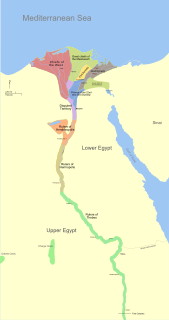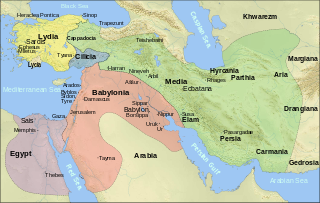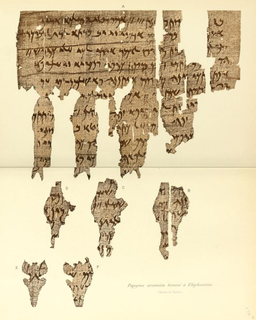Related Research Articles

The year 656 BC was a year of the pre-Julian Roman calendar. In the Roman Empire, it was known as year 98 Ab urbe condita. The denomination 656 BC for this year has been used since the early medieval period, when the Anno Domini calendar era became the prevalent method in Europe for naming years.
The year 525 BC was a year of the pre-Julian Roman calendar. In the Roman Empire, it was known as year 229 Ab urbe condita. The denomination 525 BC for this year has been used since the early medieval period, when the Anno Domini calendar era became the prevalent method in Europe for naming years.
This article concerns the period 619 BC – 610 BC.
The year 652 BC was a year of the pre-Julian Roman calendar. In the Roman Empire, it was known as year 102 Ab urbe condita. The denomination 652 BC for this year has been used since the early medieval period, when the Anno Domini calendar era became the prevalent method in Europe for naming years.
The year 664 BC was a year of the pre-Julian Roman calendar. In the Roman Empire, it was known as year 90 Ab urbe condita. The denomination 664 BC for this year has been used since the early medieval period, when the Anno Domini calendar era became the prevalent method in Europe for naming years.

Apries is the name by which Herodotus and Diodorus designate Wahibre Haaibre, a pharaoh of Egypt, the fourth king of the Twenty-sixth dynasty of Egypt. He was equated with the Waphres of Manetho, who correctly records that he reigned for 19 years. Apries is also called Hophra in Jeremiah 44:30.
The year 595 BC was a year of the pre-Julian Roman calendar. In the Roman Empire, it was known as year 159 Ab urbe condita. The denomination 595 BC for this year has been used since the early medieval period, when the Anno Domini calendar era became the prevalent method in Europe for naming years.
The year 589 BC was a year of the pre-Julian Roman calendar. In the Roman Empire, it was known as year 165 Ab urbe condita. The denomination 589 BC for this year has been used since the early medieval period, when the Anno Domini calendar era became the prevalent method in Europe for naming years.

Wahibre Psamtik I (Ancient Egyptian: wꜣḥ-jb-rꜥ psmṯk, known by the Greeks as Psammeticus or Psammetichus, who ruled 664–610 BC, was the first of three kings of that name of the Saite, or Twenty-sixth Dynasty of Egypt.

Psamtik II was a king of the Saite-based Twenty-sixth dynasty of Egypt. His prenomen, Nefer-Ib-Re, means "Beautiful [is the] Heart [of] Re." He was the son of Necho II.
The Twenty-eighth Dynasty of Egypt is usually classified as the third dynasty of the Ancient Egyptian Late Period. The 28th Dynasty lasted from 404 BC to 398 BC and it includes only one Pharaoh, Amyrtaeus (Amenirdis), also known as Psamtik V or Psammetichus V. Amyrtaeus was probably the grandson of the Amyrtaeus of Sais, who is known to have carried on a rebellion in 465–463 BC with the Libyan chief, Inarus, against the satrap Achaemenes of Achaemenid Egypt.

Psamtik III was the last Pharaoh of the Twenty-sixth Dynasty of Egypt from 526 BC to 525 BC. Most of what is known about his reign and life was documented by the Greek historian Herodotus in the 5th century BC. Herodotus states that Psamtik had ruled Egypt for only six months before he was confronted by a Persian invasion of his country led by King Cambyses II of Persia. Psamtik was subsequently defeated at the Battle of Pelusium, and fled to Memphis where he was captured. The deposed pharaoh was carried off to Susa in chains, and later committed suicide.

The Third Intermediate Period of Ancient Egypt began with the death of Pharaoh Ramesses XI in 1070 BC, which ended the New Kingdom, and was eventually followed by the Late Period. Various points are offered as the beginning for the latter era, though it is most often regarded as dating from the foundation of the Twenty-Sixth Dynasty by Psamtik I in 664 BC, following the expulsion of the Nubian Kushite rulers of the Twenty-fifth Dynasty by the Assyrians under King Assurbanipal. The concept of a "Third Intermediate Period" was coined in 1978 by British Egyptologist Kenneth Kitchen.

The year 655 BC was a year of the pre-Julian Roman calendar. In the Roman Empire, it was known as year 99 Ab urbe condita. The denomination 655 BC for this year has been used since the early medieval period, when the Anno Domini calendar era became the prevalent method in Europe for naming years.
Napata was a city of ancient Nubia on the west bank of the Nile at the site of modern Karima, Sudan. It was the southernmost permanent settlement in the New Kingdom of Egypt and the main Nubian cult centre of Amun. It was the sometime capital of the Nubian Twenty-fifth Dynasty and, after its fall in 663 BC, of the Kingdom of Kush. In 593 BC, it was sacked by the Egyptians and the Kushite capital was relocated to Meroë. The city was sacked a second time by the Romans in 23 BC but was rebuilt and continued as an important centre of the Amun cult.

The Late Period of ancient Egypt refers to the last flowering of native Egyptian rulers after the Third Intermediate Period in the 26th Saite Dynasty founded by Psamtik I, but includes the time of Achaemenid Persian rule over Egypt after the conquest by Cambyses II in 525 BC as well. The Late Period existed from 664 BC until 332 BC, following a period of foreign rule by the Nubian 25th dynasty and beginning with a short period of Neo-Assyrian suzerainty, with Psamtik I initially ruling as their vassal. The period ended with the conquests of the Persian Empire by Alexander the Great and establishment of the Ptolemaic dynasty by his general Ptolemy I Soter, one of the Hellenistic diadochi from Macedon in northern Greece. With the Macedonian Greek conquest in the latter half of the 4th century BC, the age of Hellenistic Egypt began.

Amyrtaeus or Amyrtaios of Sais, is the only Pharaoh of the Twenty-eighth Dynasty of Egypt and is thought to be related to the royal family of the Twenty-sixth Dynasty. He ended the first Persian occupation of Egypt and reigned from 404 BC to 399 BC. Amyrtaeus' successful insurrection inaugurated Egypt's last significant phase of independence under native sovereigns, which lasted for about 60 years until the Battle of Pelusium in 343 BC.
Ashur-uballit II, also spelled Assur-uballit II and Ashuruballit II, was the final king of Assyria, ruling from his predecessor Sinsharishkun's death at the Fall of Nineveh in 612 BC to his own defeat at Harran in 609 BC. He was possibly the son of Sinsharishkun and likely the same person as a crown prince mentioned in inscriptions at the Assyrian capital of Nineveh in 626 and 623 BC.
The Twenty-sixth Dynasty of Egypt was the last native dynasty to rule Egypt before the Persian conquest in 525 BC. The dynasty's reign is also called the Saite Period after the city of Sais, where its pharaohs had their capital, and marks the beginning of the Late Period of ancient Egypt.
The Sack of Thebes took place in 663 BC in the city of Thebes at the hands of the Neo-Assyrian Empire under king Ashurbanipal, then at war with the Kushite Twenty-fifth Dynasty of Egypt under Tantamani. After a long struggle for the control of the Levant which had started in 705 BC, the Kushites had gradually lost control of Lower Egypt and, by 665 BC, their territory was reduced to Upper Egypt and Nubia. Helped by the unreliable vassals of the Assyrians in the Nile Delta region, Tantamani briefly regained Memphis in 663 BC, killing Necho I of Sais in the process.
References
| This BC year article is a stub. You can help Wikipedia by expanding it. |